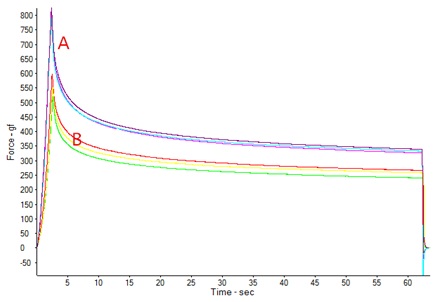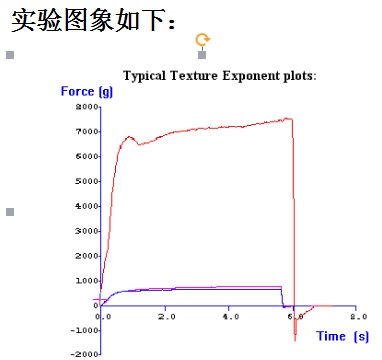Candy can be divided into hard candy, hard sandwich candy, cream candy, gel candy, polished candy, gum-based candy, aerated candy and tablet candy. Different types of candy have different texture characteristics. The different ingredients added to the chocolate manufacturing process have also created its changing face. Pure fat chocolate on the market, according to the national standard GB/T 19343 can be divided into dark chocolate, total cocoa solids ≥ 30%; milk chocolate, total cocoa solids ≥ 25% and total milk solids ≥ 12%; white chocolate, cocoa butter ≥20% and total milk solids ≥14%, and the content of solids directly affects the texture characteristics of chocolate. Therefore, we should establish a standard method of quality evaluation during the processing of candy and chocolate to minimize the sensory evaluation. Error, the texture analyzer is applied to the quality evaluation of candy and chocolate, which can reduce the error caused by subjective factors in the sensory analysis and evaluation process, and improve the reliability, accuracy and operability of the sensory. At present, a large number of reports have reported on the analysis of the processing conditions and the quality of the processing of candy and chocolate by the texture analyzer. Zhou Xiaoli [1] reported using the texture analyzer to analyze the elasticity, cohesiveness, adhesiveness and chewing of the milk candy. Sex, recovery, hardness, the test uses a cylindrical P/2 probe and full texture mode (TPA), taking the flat portion of the milk sugar evenly tested. Jiang Song [2] studied the texture of five kinds of chocolate by sensory evaluation and instrumental measurement (puncture, three-point bending and TPA). The puncture test used p/2 probe, before, during and after measurement. The moving speed of the probe is 1 mm/s, the puncture distance is 1.5 mm, and the sample is made into a rectangular parallelepiped with length, width and height of 18, 14, and 6 mm respectively. The three-point bending test condition is HDP/3PB probe; the bending span is 12 mm; test rate It is 0.5mm/s, the test rate is 1mm/s before and after the test; the loading distance is 10mm, and the sample is made into a standard rectangular parallelepiped with a length of 18mm, a width of 14mm and a thickness of 6mm. TPA adopts P100 probe; the test rate is 0.5mm/s, the rate before and after the test is 1.0mm/s; the compression ratio is 60%; the residence time is 5s, the sample is made 10 mm long, 6 mm wide and 6 thick. Standard cuboid of mm. Both test results indicate that the texture analyzer can effectively replace the sensory evaluation to evaluate the texture characteristics of candy and chocolate. Here are two ways to analyze the quality of the candy and chocolate quality of the Baosheng brand TA.XTC (for reference only): Figure 1 is a texture diagram analyzing the firmness and elasticity of two viscous sugars. Figure 1 Texture map of sticky sugar This test uses a 35mm column probe (TA/35), using a single test mode (Basic Single Test), the probe compression ratio is 20%, the moving speed of the probe before, during and after the test is 1.0 mm / s , 1.0 mm / s, 10 mm / s, image capture rate of 200. As can be seen from Figure 1, once the inductive force reaches 5g, the probe will compress the sample by 20%. At this distance, hold for 60 seconds and then withdraw from the sample. The experimental curve shows the firmness and elastic ratio of the sample. It is reflected by the curve in the figure: the hardness of the sample A is large, and the hardness of the sample B is small. The elastic ratio refers to the ratio of the holding force of the sample to the maximum positive force. It can be roughly seen from the figure that the difference between the two is small. The firmness and elastic ratio of sample A were 798.550±26.451gf and 0.4095±0.0061, respectively. The firmness and elastic ratio of sample B were 575.875±51.412gf and 575.875±51.412, respectively. Figure 2 is a texture analysis of chocolates with different shelf life using a texture analyzer. Figure 2: Texture of chocolate This test uses a 4mm column probe (P/4) using a 25kg force sensor. In the single test mode (Basic Single Test), the probe is pressed down to a depth of 6 mm. The moving speeds of the probes before, during and after the test are 2 mm/s, 1 mm/s, and 10 mm/s, respectively. For 200 pps, try to take the sample out of the bag before the experiment, place it under the center of the probe, and start the experiment. As can be seen from Figure 1, once the inductive force is reached, the probe begins to puncture a depth of 6 mm. The force begins to increase rapidly as it penetrates the surface of the sample, and then the force begins to remain stable until the end of the experiment. The resistance of the food stored for one week is large, indicating that the texture of the sample has deteriorated. During the storage period of 3 months and 6 months, there was not much change in the hardness of the sample, which means that the texture of the sample did not change much after three months. The experimental analysis shows that the longer the shelf life of the sample, the lower the hardness of the chocolate. The hardness of the chocolate in the three samples was 7042.1±202.7 g, 851.0±65.4 g, and 800.6±19.0 g, respectively, with the extension of the shelf life. references: [1] Zhou Xiaoli, Zhou Mingming, Zhao Lin. Study on the evaluation method of texture properties of milk sugar[J]. FOOD industry, 2008(6):45-46. [2] Zhao Yanwei, Wang Yusheng, Chen Haihua. Study on the Correlation between Texture and Sensory Evaluation of Bean Products[J]. Journal of Qingdao Agricultural University, 2012, 29(2): 126-131. chewable probiotics,acidophilus tablets,Probiotic Tablets,lactobacillus tablet Biodep Biotechnology Co. ,Ltd. , https://www.mbioda.com
